EURO GRAIN HUB Exchange & Forum: grain prices in Europe depend on Ukraine

What the grain market is like today and what is expected for tomorrow – these topics were discussed by global experts at the international forum EURO GRAIN HUB Exchange & Forum, held on April 26-28 in Bucharest. The event was organized by UkrAgroConsult, AgriPortal (Romania) and AgroPortal (Bulgaria).
Experts spoke about the state of the agricultural sector in Eastern Europe, the prospects for grain markets, and the growth of global grain consumption. The main question they asked was what prices for grains and oilseeds will be in Europe and on the global market.
“When we ask whether the price trend will be upward or downward, the answer is in Ukraine. If Ukraine exports 14 million tons of grain, there will be one result, if it exports 5 million tons, the picture will be completely different. Of course, Europe can import something from Brazil or Argentina, but the cost of delivery is strikingly different,” emphasized Mykola Gorbachev, President of the UGA.

Mykola Gorbachev, President of the Ukrainian Grain Association
European prices not only for grain but also for meat and other food products depend on Ukraine, he emphasized. That is why we have selected the key points of the conference that concerned Ukraine and our prospects on the global market.
Ukraine on the global market

Lindsay Malecha, USDA analyst
First, the good news. Despite the hostilities, Ukraine remained among the top wheat exporters in the previous and current seasons. As USDA analyst Lindsay Malecha noted in her speech, in general, this season the global wheat exports exceeded 200 mln tons. Ukraine remained the sixth largest exporter of the crop.
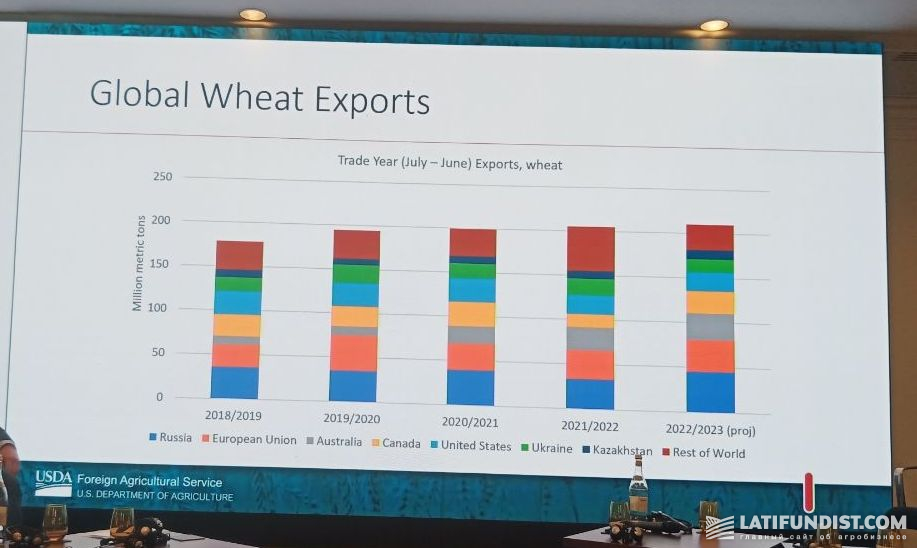
Top wheat exporters in the world
Thanks to the Grain Corridor and Solidarity Roads, Ukraine’s corn stocks are much smaller than they were last season. According to Mykola Gorbachev, they currently amount to about 10 million tons.
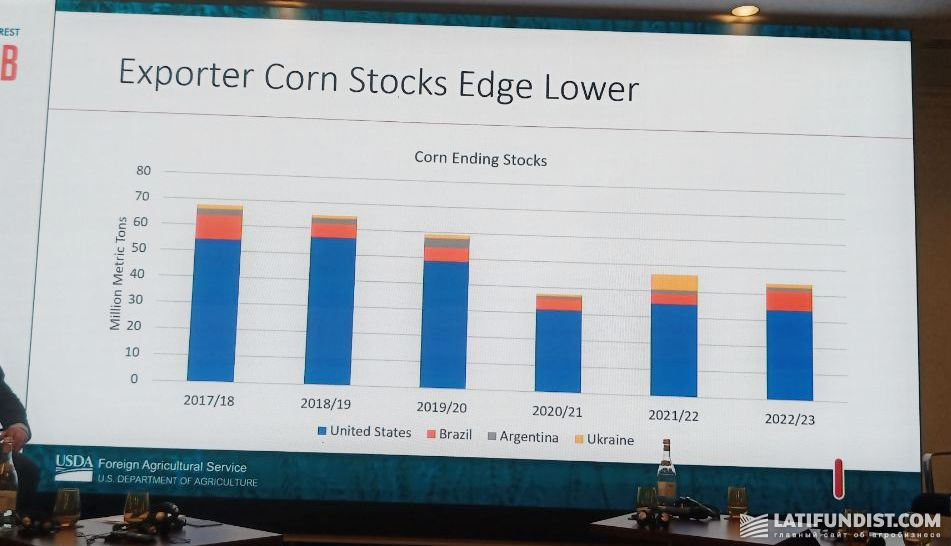
The remains of corn
We should also mention Egypt: Ukraine has become the main exporter of grain crops to this country since the beginning of 2023. During this period, the volume of corn supplies amounted to 1.55 mln tonnes.
However, in general, Egypt imported less grain last year than it usually does. This was stated by the FAO phytosanitary consultant Islam Aboelela.

Islam Aboelela, FAO Phytosanitary Consultant
“It was a difficult year for Egyptian imports. Egypt purchased only 9 million tons of wheat, the lowest amount since 2010. We usually import more than 10 million tons: 12 to 13.5 million tons. Imports of corn were also lower – 8 million tons. We imported 9.5 mln tons of soybeans, but we also supplied alternative products – soybean and sunflower meals,” Islam Aboelela said.
He noted that for the first time in 15 years, Brazil supplied wheat and corn to Egypt, and Moldova and India became the new exporters.
In his commentary to our journalists, Islam Aboelela said that Egypt is in dire need of Ukrainian grain. Due to the hostilities, there are problems with logistics, the most important one being ship insurance. The FAO representative noted that due to difficulties with ship insurance, carriers are in no hurry to work with Ukraine.
The expert also emphasized the need for enhanced grain testing for the fungus Tilletia controversa, as some countries have recently seen outbreaks of this disease.
Oilseeds
Oilseeds were discussed the most at the EURO GRAIN HUB forum. In 2022/23 marketing year, the global production of sunflower and rapeseed increased. According to the USDA analyst Gretchen Kuck, Brazil, the USA, Canada and Australia became the largest producers of oilseeds and oilseed products over the last 10 years.
She noted that prices for oilseeds on the global market remain high. In 2022, when the full-scale invasion occurred, the cost of oilseeds reached record levels, as can be seen from the USDA chart. During the year, the prices dropped, but still remain high due to production costs and inflation.
In the first half of this MY, Ukraine exported a record amount of sunflower – 1.54 mln tons. The main importers were Bulgaria and Romania. In a comment to our journalists, Yulia Garkavenko, a leading analyst at Ukragroconsult, noted that Bulgaria is now showing incredible exports of oil and meal using Ukrainian grain. She noted that the longer the war lasts, the more likely it is that Romania will also start changing its processing industry.
Yulia Garkavenko
leading analyst at Ukragroconsult
“How to return our sales markets will be the main problem after the war.”
Forecasts for the next season
A significant part of the experts’ speeches was devoted to forecasts. Although forecasting anything today is a thankless task, Ukrainian analysts emphasized. Interestingly, the assumptions about the future oilseed harvest in Ukraine were called optimistic by European colleagues.

Denis Sobolev, FAS USDA analyst in Kyiv
If we look at the changes in sown areas compared to last year, Denis Sobolev, FAS USDA analyst in Kyiv, said the following:
- The area under grain will decrease by about 20.4%. Farmers will cut rye the most, wheat the least. It is predicted that corn will be planted by 22% less, so the total area under the crop may reach 3.3 million hectares.
- Oilseeds are likely to increase by 112% compared to last year. The largest increase is expected for soybeans – 136% more, while sunflower areas, according to analysts of the USDA Kyiv office, may grow by 108% compared to last year’s areas.
Leading analyst of Ukragroconsult Maryna Marynych estimated the sunflower production in 2023 at 13.3 mln tons. In 2022, the crop was harvested at 11 mln tons. In general, the company estimates the future oilseed harvest at 21.4 mln tons.

Maryna Marynych, leading analyst at Ukragroconsult
Will Ukraine be able to ensure the required quality of the harvest? This is another question that our speakers were asked.
- “As for the quality of grain, I am sure that all large holdings are 100% provided with high-quality seeds. As for small and medium-sized companies, I can’t be 100% sure, but I know the mentality of Ukrainian farmers: if they have tried high-quality seeds, it will be very difficult to go back to worse options. So, most likely, in the fall we will see that the whole harvest will be of good quality,” said Maryna Marynych.
Forecast from the Ukrainian Grain Association
In general, the UGA estimates the future harvest at 66 million tons of grains and oilseeds, of which Ukraine is likely to be able to export 44 million tons. Mykola Gorbachev noted that the future corn harvest raises the most questions.
“The biggest difference we face in the forecasts is corn production, because no one knows the real area for this crop. But our expectations are quite low,” said Mr. Gorbachev.
He emphasized that such a harvest is a return of Ukrainian agriculture ten years in the past. To recover to the level of 2021, farmers will need 5-6 seasons.
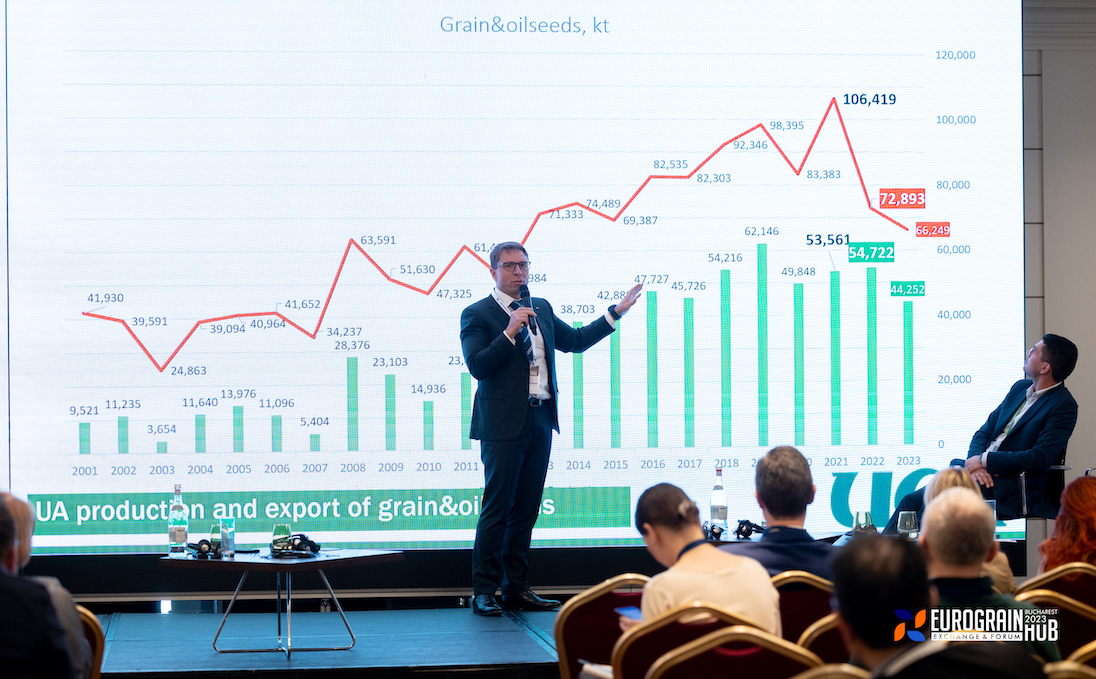
Mykola Gorbachev, President of the Ukrainian Grain Association
Future export scenarios: without and with the grain corridor
Denys Sobolev, FAS USDA analyst in Kyiv, showed the infographics of grain exports in January, February and March 2023 and the main logistics routes. During this period, Ukrainian farmers exported 19.26 mln tons of agricultural products.
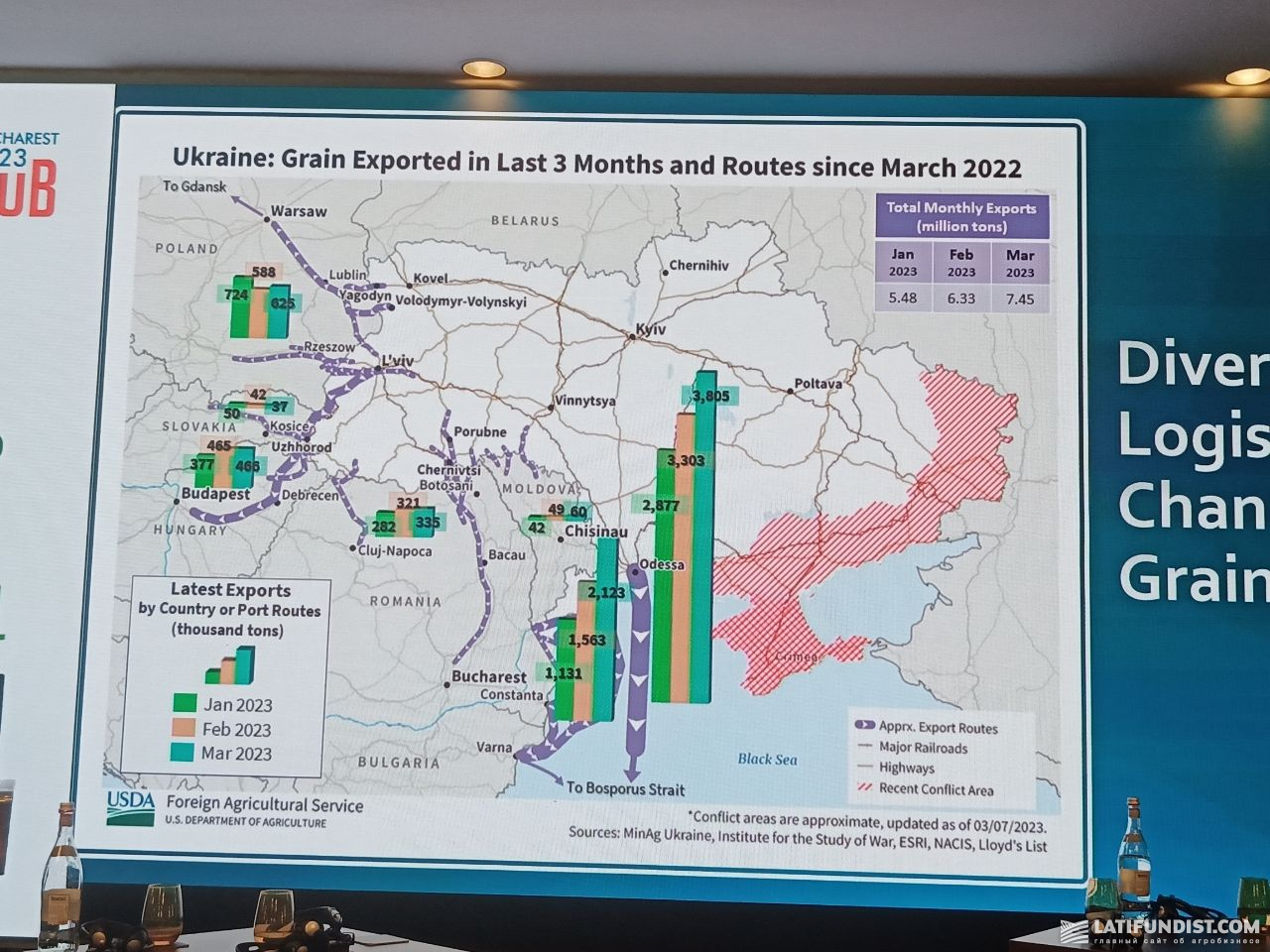
Grain exports from Ukraine
In April, the Russian side of the SCC sabotaged the grain corridor, and Russia said that the agreement on the export of Ukrainian agricultural products via the Black Sea would end on May 18.
The USDA’s FAS in Kyiv predicted two scenarios for oilseed exports: optimistic, if the corridor continues to operate, and pessimistic, if the Danube ports and transit via the “solidarity routes” are used. The forecast is also based on the assumption that military actions will not cause significant damage to oilseed processing capacities.
According to the optimistic scenario, Ukraine can export 6.1 million tons of oilseeds, 5.4 million tons of oil, and 2.2 million tons of meals. If the grain deal does not work, exports of sunflower will decrease, while supplies of soybeans and rapeseed will increase. It is also forecasted that the export of meals will be 32% lower in this case.
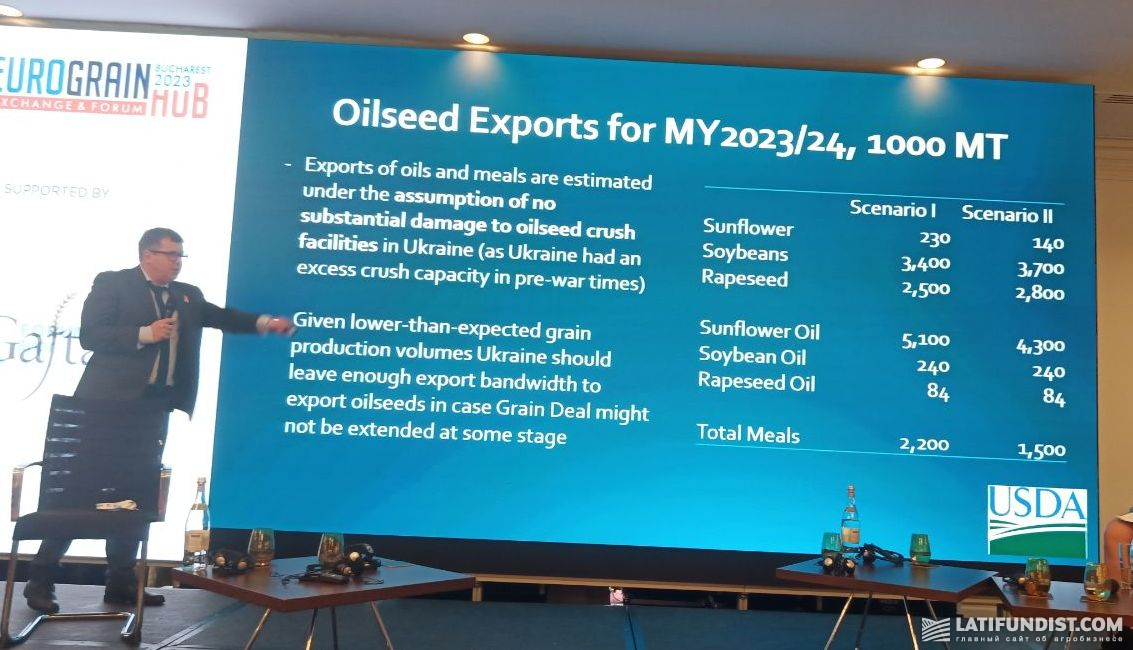
Denis Sobolev, FAS USDA analyst in Kiev
Constanza: what do expect in Romania
Through the Romanian port of Constanta Ukraine exported 3.4 million tons of corn and more than 1.5 million tons of wheat in this MR. Romanian, as well as Serbian, Hungarian and Bulgarian agricultural products are transshipped in the port. For comparison, in 2020/21 MY Constanta handled 15.4 million tons of agricultural cargoes, in 2021/22 – 21.2 million tons. This season has already transshipped 16.5 million tons, but the port hopes to close the marketing year with a result more than 21 million tons.
This was told by the trader of Cargill company in Romania, Alexandru Neagu. He predicted two scenarios for Ukraine’s exports through the Romanian port.
“If the “grain agreement” does not work, we expect to take about 12 million tons of Ukrainian grain, and with the current “corridor” – about 9 million tons,” – said the speaker.

Alexandru Neagu, Cargill trader in Romania
However, this year Romania hopes to get a much larger harvest, and a similar situation will be in Serbia, which exports agricultural products through the Romanian port. The question of whether Constanta will be able to handle the grain flows if the Black Sea Corridor is closed remains open.
The Ukrainian Danube Shipping Company said that Constanta could increase the transshipment of Ukrainian grain by transshipment from barges to seagoing vessels on a side-by-side basis. According to Vladislav Belakh, the head of the UDP, this logistics scheme has been worked out in six months and is ready for scaling.
At the same time, Ukrainian companies continue to increase the capacity of ports on the Danube. NIBULON, Kernel and others are investing in new facilities. As Mykola Gorbachev noted, today we can export 1.8-1.9 million tons through the Danube river ports, and these volumes will increase.
Many challenges, many problems. “Our planning horizon is very limited,” analysts say. Nevertheless, the investments of large companies in transshipment capacities give us hope that the Ukrainian agricultural industry will continue to operate.
Read also
Black Sea Grains and Oilseeds: Export Flows and the Future Potential. Outlook for ...
Wheat export prices rise in Ukraine due to limited supply
India’s Sunflower Oil Imports Up 17.8% in June – SEA
About 46% of Ukrainian flour was exported to the EU in the 2024/25 season
US soybean crops show significant improvement
Write to us
Our manager will contact you soon



